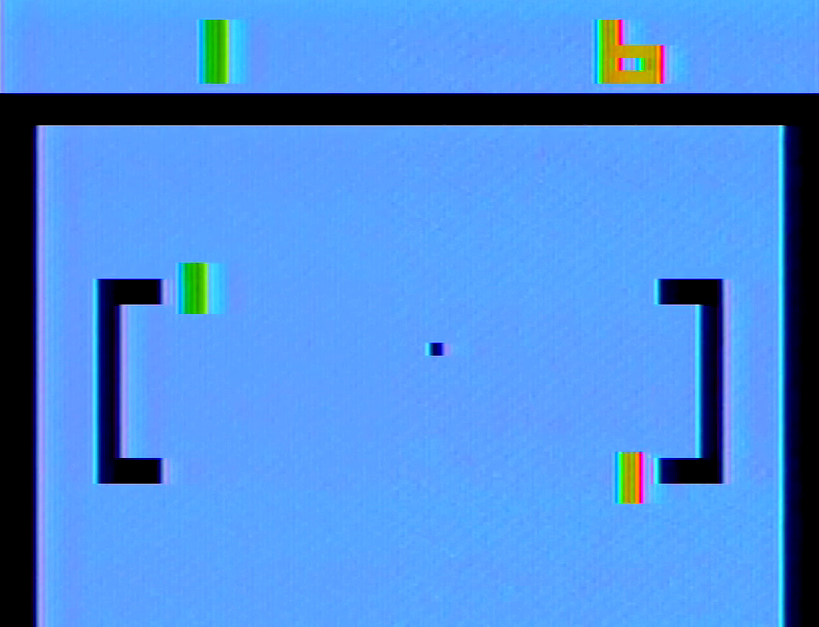
When the VCS hardware was being conceived by Jay Miner and Joe Decuir, their mission was to build a console capable of playing, at minimum, home versions of Atari’s Tank and Pong arcade games. Tank was the proof of concept game that would later be fleshed out into the pack-in title Combat by Larry Wagner, but even after hiring a group of programmers in 1976, by early 1977 nobody had taken up the task of writing a commercially viable Pong game for the system.
Of course, even by 1977 Pong was an old game concept. The arcade version launched in 1972 as the first commercial game released by Atari following the Computer Space game that Atari founder Nolan Bushnell had worked on alongside Ted Dabney. Computer Space had been published by Nutting Associates the previous year, but was considered in retrospect by Bushnell to be too hard to control for a game set up in bars and bowling alleys. Bushnell tasked early hire Al Alcorn with recreating a simplified version of the Magnavox Odyssey’s tennis game using arcade hardware as a test project, to familiarize himself with Dabney’s circuitry and their game design technology in general. Bushnell motivated Alcorn by telling him they already had a contract with General Electric to produce this game and that it had to cost less than $15 in parts. Alcorn simplified the game design from the Odyssey by eliminating the extra paddles that allowed players to move horizonally and affect the ball’s flight directly; instead, players can only move along a vertical axis, and the ball’s angle is determined entirely by where it connects with the paddles. Bushnell wanted cheering and boos as background audio, but Alcorn simply found tones that were already being generated by the game and hooked them into the speaker instead.
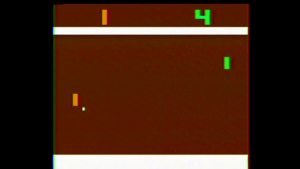 Alcorn’s Pong project ended up being pretty fun, and after some cajoling Alcorn and Dabney convinced Bushnell to give it a trial run as a commercial product. A prototype unit was set up at Andy Capp’s Tavern in Sunnyvale, and over the course of a few weeks it proved to be a popular attraction, even bringing in people who weren’t there to drink. Atari considered who could publish it – Bally passed on it, believing the intake numbers were too high, Nutting was disinterested, and so Atari ended up releasing it and producing the first video arcade hit in the process. Atari would look into different ways to package Pong for different markets – Barrel Pong for wineries, Puppy Pong for pediatrician office waiting rooms – and eventually produce various spins on the game, adding in new players and mechanical tweaks. And they weren’t alone – engineers from Ramtek were among the early Pong players at Andy Capp’s Tavern, and published their own version on March 1973 called Volly, right around the same time Atari started promoting Pong nationally. Allied Leisure, Midway, For-Play, Nutting Associates and more were producing clones of Pong, as Atari’s own inability to meet demand for the game gave other companies an opening to get in on the craze. Nevertheless, Atari had broken open the floodgates and showed there was a serious market for video games in the arcade space – even if a lot of them were Pong.
Alcorn’s Pong project ended up being pretty fun, and after some cajoling Alcorn and Dabney convinced Bushnell to give it a trial run as a commercial product. A prototype unit was set up at Andy Capp’s Tavern in Sunnyvale, and over the course of a few weeks it proved to be a popular attraction, even bringing in people who weren’t there to drink. Atari considered who could publish it – Bally passed on it, believing the intake numbers were too high, Nutting was disinterested, and so Atari ended up releasing it and producing the first video arcade hit in the process. Atari would look into different ways to package Pong for different markets – Barrel Pong for wineries, Puppy Pong for pediatrician office waiting rooms – and eventually produce various spins on the game, adding in new players and mechanical tweaks. And they weren’t alone – engineers from Ramtek were among the early Pong players at Andy Capp’s Tavern, and published their own version on March 1973 called Volly, right around the same time Atari started promoting Pong nationally. Allied Leisure, Midway, For-Play, Nutting Associates and more were producing clones of Pong, as Atari’s own inability to meet demand for the game gave other companies an opening to get in on the craze. Nevertheless, Atari had broken open the floodgates and showed there was a serious market for video games in the arcade space – even if a lot of them were Pong.
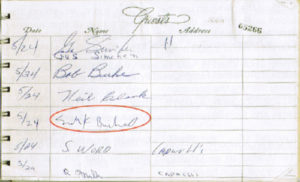
Less pleased were Magnavox and Ralph Baer, who in the 1960s led the team that created the Odyssey in the first place. Bushnell publicly claimed that he had never seen the Odyssey in action before in his life, a claim deflated when it came to light that he had signed into a trade show that showed off the 1972 game console. After a legal dispute, eventually Atari and Magnavox reached a settlement: Atari was able to continue to produce Pong and could make home consoles based off of Baer’s video signal technology as long it paid royalties to Magnavox. While there has been speculation that the success of Pong (and its clones) may have led to increased Odyssey sales, Baer disputed this in his book Videogames in the Beginning as the system was well received by retailers, had already sold 80,000 units in 1972, and practically monopolized the home video game market into 1974 (when the URL Video Action and the Videomaster Home TV Game were published in the US and UK, respectively; neither were particularly successful).
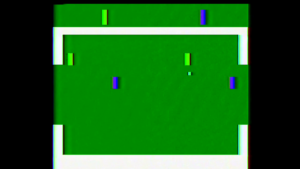 Atari joined a slew of other manufacturers in producing its own home version of Pong in 1975 – though Atari, unlike most other companies, did not use General Instruments’ AY-3-8500 “Pong on a chip” integrated circuit, but rather had engineer Harold Lee work work on it. and while the game was long in the tooth by 1977 it seemed like an obvious choice for the VCS project. After all, its console competitors – the Fairchild Channel F and RCA Studio II – had their own renditions of the game available by the middle of the year, and dedicated home consoles were still being produced to bring the game into the recreation room. And Atari had released several variants of Pong over the years in arcades too, adding paddles to create Super Pong and Ultra Pong. Added to all the other companies producing Pong clones at home and in arcades, the game still had its fair share of name recognition.
Atari joined a slew of other manufacturers in producing its own home version of Pong in 1975 – though Atari, unlike most other companies, did not use General Instruments’ AY-3-8500 “Pong on a chip” integrated circuit, but rather had engineer Harold Lee work work on it. and while the game was long in the tooth by 1977 it seemed like an obvious choice for the VCS project. After all, its console competitors – the Fairchild Channel F and RCA Studio II – had their own renditions of the game available by the middle of the year, and dedicated home consoles were still being produced to bring the game into the recreation room. And Atari had released several variants of Pong over the years in arcades too, adding paddles to create Super Pong and Ultra Pong. Added to all the other companies producing Pong clones at home and in arcades, the game still had its fair share of name recognition.
Which brings us back to the VCS. Decuir said that Pong being included was a no-brainer, and he purposely made sure the hardware was built to accommodate the game during development. For example, the system is built to support two player sprites, two missile sprites, and – pretty much just for Pong – one ball sprite. Additionally, the VCS hardware through its TIA chip was specially built to read paddle controllers, used in the arcade Pong game and in its standalone home version, by reading the electrical resistance each paddle’s internal potentiometer produced in its current position. Each controller port could support two paddles, allowing for a maximum of four players. Finally, he made sure the hardware included collision detection routines so that programmers – including whoever was to work on Pong – wouldn’t have to cram that into software too.
Larry Wagner had created a basic version of Pong in an early version of Combat while the VCS hardware was still being finalized, but this code was not included in the final revision of the cartridge. And ultimately when no one else was working on the game by February 1977, Decuir picked up the project himself, telling supervisor Bob Brown that he could think of a lot of variations of Pong; Brown agreed to let him constrain that to 50 variants and Decuir got to work on what would be released as Video Olympics.
Decuir did not exaggerate about the number of variations on this simple game he could cram into a two kilobyte cartridge. He arranged eight prime games, making sure that they had games that were horizontal, vertical, or a mix. Aside from standard Pong, he included Super Pong – adding a second paddle for each player, allowing for some trick shots in the middle of the playfield; Pong 4, a four player version of Super Pong akin to the arcade game Pong Doubles; and Quadra-Pong, a four-player team version where each player had a goal on one side of the screen, teaming with another player against the other two.
Those relatively standard versions of Pong were just the beginning. Decuir also created variations on the theme based on other sports: by changing some graphics, he made Foozpong, where each player had multiple paddles across the screen; and both hock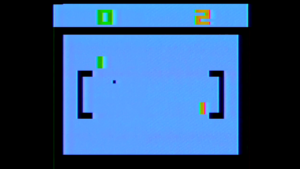 ey and soccer, where the ball had to enter a specified goal area. Flipping the screen brought along basketball, where the ball has to be dribbled and then bounced into a net, and volleyball, where players bounce the ball over a net at one another. Using the button causes players to catch and hold the ball, “throw” the ball in basketball games, or leap up to spike it in volleyball. Finally there was handball, where each player bounces a ball off the wall and their opponent has to catch it.
ey and soccer, where the ball had to enter a specified goal area. Flipping the screen brought along basketball, where the ball has to be dribbled and then bounced into a net, and volleyball, where players bounce the ball over a net at one another. Using the button causes players to catch and hold the ball, “throw” the ball in basketball games, or leap up to spike it in volleyball. Finally there was handball, where each player bounces a ball off the wall and their opponent has to catch it.
Nearly all of these have options for four players. The difficulty switches change the size of the paddles, and variations also include two uses for the button when hitting the ball to simulate hitting it harder: a “whammy” option where the ball will careen off at a sharp angle for as long as the player holds the button, or a “speed up” function that essentially kicks the ball up to its fastest speed immediately. This mix of variations is playable to varying degrees, though Decuir himself feels that FoozPong is basically unplayable given how much is happening so fast. The game also features a key difference from the arcade in how many angles the ball can be hit in; arcade pong only registers three directions, but a skilled player can knock the ball five ways on the VCS version, including a sharp angle at the edge of the paddle.
Based on feedback from the arcade version, Decuir included a single-player version of Pong, dubbed “Robot Pong,” as the default game to give players a chance to practice. The arcade game could only be played with two people, and Decuir said players at the time really wanted a single-player version of the game to play in case they didn’t have a partner – Atari never produced an one player game, and it was left out of Atari’s dedicated home Pong game. But with a processor, Decuir felt he could make a decent challenge.
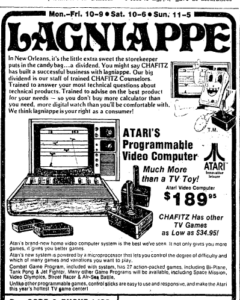
In Robot Pong, an AI controls the left paddle using a simple algorithm. To counter the fact that the computer could in theory play Pong perfectly, Decuir programmed it to follow the vertical placement of the ball, but imperfectly. The computer starts off aligning the top of the paddle with the ball, but every 8 frames will skip its alignment routine; over time this causes it to drift off enough to miss the ball and limiting its overall speed. It will also realign itself each time the ball bounces off a wall, creating strategies of hitting the ball at an angle that the AI will whiff or getting the ball moving so fast that it can’t keep up. The AI routines are simple, are compact enough to have been squeezed into the cartridge, and work well for Pong. According to the book about the VCS called Racing the Beam, the developers of the 1999 Atari Arcade Hits collection ended up copying the Video Olympics AI for its own single player Pong version. It wasn’t alone as a game with an AI opponent in contemporary home action games, but in terms of providing a challenge without being insurmountable it was a strong contender in comparison to other 1977 releases: fellow VCS launch game Air-Sea Battle’s computer opponent constantly fired into the air due to a lack of room on the cartridge. Michael Glass’s dogfighting game Spitfire on the Channel F did include a fairly impressive AI opponent upon its debut in April 1977, complete with a difficulty that adjusts based on how well the human player is doing, but on the whole isn’t quite as challenging to compete against. Spitfire itself is largely only known today for featuring an easter egg that wasn’t discovered until 2019. The Gunfighter game released around September on the RCA Studio II included a simple computer opponent as well, but that title struggled against the platform’s limitations and unsuitability for action games.
After three months of programming and the time spent designing the hardware around what he would need for Pong, Video Olympics was completed. Decuir said that he included all the variations he wanted, though with more cartridge space he would have liked to include single player options for all the games on the cart. He has also noted that he didn’t use any of Wagner’s code from the initial Combat prototype for his cartridge.
Decuir believes that Atari being a game company first meant their staff was focused more on making sure that games played well more than its early competitors at Fairchild and RCA, and part of that was play-testing. After cramming the game into 2048 bytes through clever usage of software interrupts, Decuir got the rest of the design team together to make sure the game was fun. This was in keeping with Nolan Bushnell’s design philosophy, as he was insistent that the best games be easy to learn and difficult to master. As Decuir noted, Bushnell would tell the design team that “They have to reward the first quarter and they have to reward the 100th quarter.”
True to Bushnell’s maxim, Video Olympics, and by extension Pong, is a surprisingly strong game in the VCS lineup. The 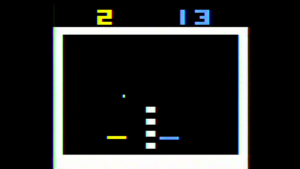 game is trickier to get the hang of for a new player than one would expect from such a simple concept, and the smooth high-speed volley between skilled opponents keeps it interesting. The gametypes with smaller goals and additional paddles can also feel easier for new players to ease into Pong, as not every whiff spells a lost point for them. While some of the variations are flatly better than others, they all feel like unique enough takes on the Pong concept that they’re worth visiting. This was spelled out in relatively contemporary reporting; in Bill Kunkel’s summer 1979 Arcade Alley column he praised the Robot Pong, Volleyball and Quadrapong variants, but was less enthused about Handball for its admittedly confusing blinking paddle setup for the inactive player, or Basketball for being outclassed for Atari’s standalone release, which came out in 1978 and featured its own strong computer opponent. Kunkel and Arnie Katz would single out the volleyball gametype on the cartridge in March 1980’s Video issue for an Arkie Award as the “Best Pong Variant,” speaking highly of the spiking mechanic and how the ball bounces higher with each successive hit. Creative Computing noted that the game was still a favorite among their reviewers in a September 1981 round-up of VCS titles, in particular the variants with a speed-up or whammy option.
game is trickier to get the hang of for a new player than one would expect from such a simple concept, and the smooth high-speed volley between skilled opponents keeps it interesting. The gametypes with smaller goals and additional paddles can also feel easier for new players to ease into Pong, as not every whiff spells a lost point for them. While some of the variations are flatly better than others, they all feel like unique enough takes on the Pong concept that they’re worth visiting. This was spelled out in relatively contemporary reporting; in Bill Kunkel’s summer 1979 Arcade Alley column he praised the Robot Pong, Volleyball and Quadrapong variants, but was less enthused about Handball for its admittedly confusing blinking paddle setup for the inactive player, or Basketball for being outclassed for Atari’s standalone release, which came out in 1978 and featured its own strong computer opponent. Kunkel and Arnie Katz would single out the volleyball gametype on the cartridge in March 1980’s Video issue for an Arkie Award as the “Best Pong Variant,” speaking highly of the spiking mechanic and how the ball bounces higher with each successive hit. Creative Computing noted that the game was still a favorite among their reviewers in a September 1981 round-up of VCS titles, in particular the variants with a speed-up or whammy option.
Unsurprisingly given the long shadow Pong cast over the video game industry, Atari’s early competitors practically all had their own takes on the game. Fairchild’s was baked into their Channel F, as the unit shipped with built-in Hockey and Tennis games. These actually date back to the original Channel F prototype, Alpex’s Project RAVEN – an Intel 8008-based black-and-white programmable game unit designed by engineers Wallace Kirschner and Lawrence Haskel (who wrote the actual game). The Channel F uses an F8 microprocessor, so the conversion was done by Fairchild engineer Vilas Munshi. Though this take has more in common with the original Odyssey Tennis game, as players can maneuver their paddles around the entire playfield, and even rotate them using the controller’s twist function to take precision shots. In Hockey, the goalie can even be controlled with the plunger up-and-down motion the controller is capable of – in all these games showcase the Channel F’s capabilities and are solid takes on the premise. At RCA, software engineer Andy Modla was tasked by marketing with writing Tennis/Squash as his second project on the Studio II. While the lack of hardware sprite control made the machine poorly suited for a tennis game, Modla added in an “English” functionality that would cause the ball to turn sometimes when it approached the opponent’s paddle. Squash is essentially his own take on a one-player experience, with the ball bouncing off a wall. Interestingly, an early prototype of the Studio II’s built-in games included a simple Pong clone – one that Modla said he never had access to while writing his own. While it works, it’s clear Modla was pushing against the limitations of the Studio II’s hardware, which lacks paddle controls. Bally would publish its own Pong clone for the Professional Arcade in 1978, with Tornado Baseball/Tennis/Handball/Hockey. The company opted to put all of its Pong clone games on one cartridge to limit the amount it would pay Magnavox in licensing fees, as the company proved quite litigious defending its patents from the original Odyssey.
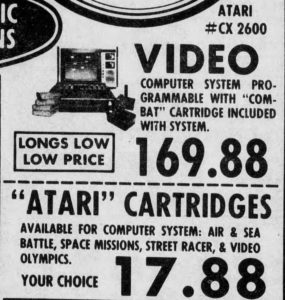
Video Olympics – also sold under the title Pong Sports at Sears – was one of the earliest VCS games advertised, showing up as available in ads as early as August and September 1977. The VCS came packed in with a pair of paddle controllers, and a simple purchase of another set turned the Video Olympics into one of the first party games. As probably the best game of the near-launch library to use the paddles, Video Olympics made a pretty strong case for their continued support. Indeed, unlike other specialty controllers for the VCS like the driving controller and the keypad, the paddles saw new game support into 1984, and remained packed in with the console until its 1986 budget rerelease. Even with paddles having to be something purchased separately, Atari did continue to sell some copies of the game in those later years, with 16,998 copies reaching stores between 1986 and 1988; while sales numbers are not quite as comprehensive prior to those years, we do know based on an internal sales document through 1984 shown in the Once Upon Atari documentary that Video Olympics sold 36,028 copies in 1980, and overall was Atari’s 18th best-selling title since 1980. And as one of the rare four-player games on the VCS, Video Olympics pioneered a home multiplayer conceit that didn’t seem to catch on in a mainstream way until 1996’s Nintendo 64 console.
Decuir didn’t work on any additional VCS games past this point, but he didn’t disappear from gaming; he went on to help design the Atari 8-bit computer line and the Amiga computer alongside Jay Miner. As for Pong itself, it has continued to be reissued in Atari compilations both as a simulated arcade game and as an emulation of the VCS version – even getting a Playstation sequel in 1999. It’s synonymous with Atari the company, consoles and brand, and its inclusion on the VCS in a perfected form was the cherry on top of its 1970s arcade port lineup.
Sources:
Joe Decuir, interview with the author, September 3 2017
Joe Decuir interview with Scott Stilphen, 2005
The Untold Story of the Invention of the Video Game Cartridge, Benj Edwards, January 22 2015
Andy Modla, interview with the author, October 2017-January 2019
Atari: Business is Fun, Marty Goldberg and Curt Vendel, 66-81, 2012
They Create Worlds: Volume 1, Alex Smith, 160-175, 210-219, 2019
Vilas Munshi, interview with the author, July 29 2019
Racing the Beam, Nick Montfort and Ian Bogost, 36-41, 2009
Videogames: In the Beginning, Ralph Baer, 76-82, 124-132, 2005
Interview with Gilbert Duncan Harrower, Inventor of the Pong-on-a-chip, Nate Lockhart, January 25 2019
Weekly Television Digest, October 17 1977
Atari Corp. 2600 Sales figures, 1986-1990
Once Upon Atari, Howard Scott Warshaw, 2003
Release Date sources
Video Olympics, September 1977: Merchandising, June 1977
Washington Post, September 16 1977
Southtown Star Sun, September 18 1977
Corvallis Gazette Times, October 29 1977
Spitfire (Channel F), April 1977: Weekly Television Digest, January 17 1977
Seattle Daily Times, April 20 1977
Los Angeles Times, April 9 1977
Hockey/Tennis (Channel F), November 1976: Jerry Lawson deposition, Fairchild v. Nintendo
Tennis/Squash (Studio II), June 1977: RCA Studio II press release package
Florence Morning News, June 11 1977
Weekly Television Digest June 6, 1977
Gunfighter/Moonship Battle (Studio II), September 1977: RCA press release November 15, 1977
Hutchinson News, November 21 1977
Galveston Daily News, September 6 1977
Tornado Baseball/Tennis/Handball/Hockey (Bally Arcade), May 1978: March 15 1978 Ernest Sams letter to JS&A
Merchandising, June 1977; Arcadians, May 29 1978
